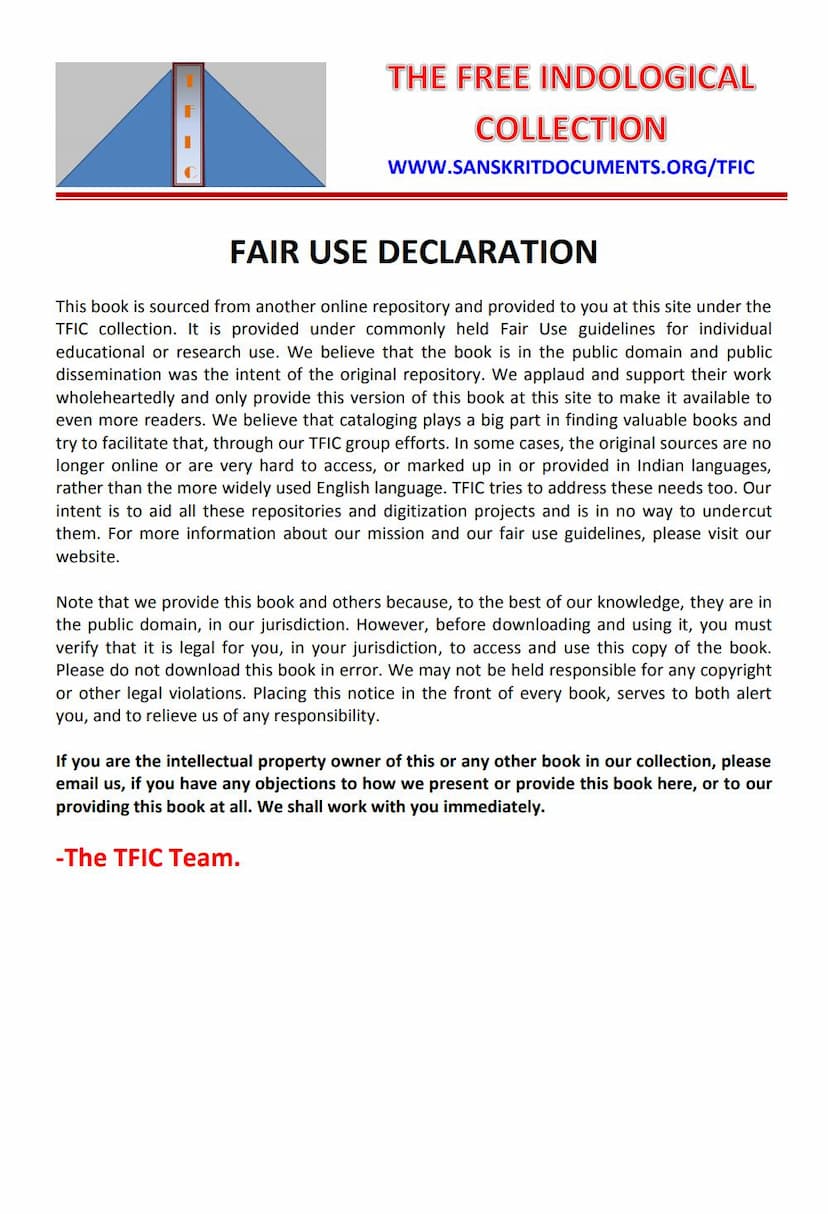Jain Shastra Sammat Drushtikon
Added to library: September 2, 2025

Summary
Here's a comprehensive summary of the Jain text "Jain Shastra sammat Drushtikon" by Nathmalmuni, focusing on the perspective of Acharya Shri Bhikshu on compassion and charity:
This book, "Jain Shastra sammat Drushtikon on Daya-Dan by Acharya Shri Bhikshu", authored by Muni Shri Nathmalji and published by Adarsh Sahitya Sangh, presents the philosophical underpinnings of the Terapanth sect's views on compassion and charity, as interpreted through the teachings of Acharya Shri Tulsi. The preface highlights that truth, especially spiritual truth, can be obscured and difficult to grasp. The book aims to clarify the often misunderstood principles of Acharya Bhikshu.
Key Themes and Arguments:
-
Distinguishing Spiritual vs. Worldly Compassion/Charity: The central argument is that Acharya Bhikshu, and by extension Terapanth, does not reject compassion and charity (Daya-Dan). Instead, he meticulously differentiates between spiritual compassion/charity, which is aimed at spiritual liberation (Moksha), and worldly compassion/charity, which is for the welfare of the worldly life (Sansar). The latter is seen as a social necessity or duty but not the path to liberation.
-
Acharya Bhikshu's "Strictness" is Clarity, Not Prohibition: The author addresses the common criticism that Terapanth prohibits acts of kindness and charity. He explains that Acharya Bhikshu's "prohibitions" were not against performing these acts but against equating them with the path to Moksha. He used strong language to emphasize that acts motivated by attachment, aversion, or delusion, even if they appear beneficial to the world, are ultimately part of the cycle of Sansar and not the path to liberation.
-
The Nature of True Ahimsa: The book delves into the Jain concept of Ahimsa (non-violence). It states that true Ahimsa, in the spiritual context, is rooted in samyama (restraint) and the absence of attachment, aversion, and delusion. Worldly compassion, while potentially good, can be driven by these very emotions, making it distinct from spiritual Ahimsa. The text quotes scriptures to illustrate that while compassion might result in saving lives, its true purpose in the spiritual realm is to eliminate attachment and aversion, not merely to preserve physical existence.
-
"Lok Dharma" vs. "Moksha Dharma": Acharya Bhikshu distinguished between "Lok Dharma" (worldly religion or social duty) and "Moksha Dharma" (spiritual religion or the path to liberation). He believed that performing worldly duties like caring for parents, helping the needy, or even acts of public welfare were essential for societal functioning (Lok Dharma) but should not be mistaken for the path to Moksha (Moksha Dharma). The confusion arises when worldly dharma is presented as the ultimate spiritual path.
-
The Role of Intention and Motivation: A significant aspect discussed is the motivation behind an act. Acts performed with attachment, ego, or a desire for worldly recognition, even if they benefit others, are not considered conducive to spiritual progress by Acharya Bhikshu. True spiritual charity stems from a detached, equanimous state of mind.
-
The Clarity of Language: The author emphasizes that Acharya Bhikshu's choice of words, such as calling worldly acts "sin" or "Samsara," was to clearly demarcate them from the spiritual path. This was not an indictment of the acts themselves but a warning against mistaking them for the means to liberation. Acharya Tulsi, in his approach, presented these same principles in a way that was more accessible to the contemporary understanding, bridging the gap between ancient teachings and modern language.
-
Misinterpretations and Criticism: The book acknowledges that Acharya Bhikshu's views have been misrepresented by critics who portray him as someone who discourages helping the needy, saving lives, or caring for parents. The author asserts that these interpretations are a distortion of his teachings. Terapanth's principle is that while these acts are not the path to Moksha, they are not prohibited. The prohibition lies in mistaking them for the path to Moksha.
-
The Concept of "Kupatra" (Unworthy Recipient): The text clarifies that when Terapanth refers to a "Kupatra" for Moksha-Dan (charity for liberation), it refers to someone who is not restrained (Asanyami), not one who is inherently bad or wicked. While worldly compassion (Anukampa) might extend to the needy, the charity that leads to spiritual liberation is only for those who have embraced spiritual discipline.
-
Comparison with Other Philosophers: The book includes quotes and perspectives from various thinkers and traditions (Yajurveda, Upanishads, Bhagavad Gita, Sankhya, Yoga, Jain Acharyas like Amitagati and Hemachandra, Mahatma Gandhi, etc.) to show that the distinction between worldly and spiritual goals, and the emphasis on detachment and true inner purity, is a recurring theme in spiritual discourse across different philosophies.
-
The Goal is Understanding, Not Condemnation: The author urges readers to approach the teachings with an open mind and to study Terapanth's literature to understand its principles accurately, rather than relying on distorted criticisms. The aim is to foster understanding and spiritual progress, not to create religious discord.
In essence, "Jain Shastra sammat Drushtikon" argues that Acharya Bhikshu's teachings on compassion and charity are profoundly spiritual, emphasizing the distinction between actions that benefit the world and actions that lead to liberation. His "strictness" is a call for clarity and discrimination in spiritual practice, encouraging individuals to seek true liberation through detachment and self-discipline, while not condemning worldly acts of kindness.